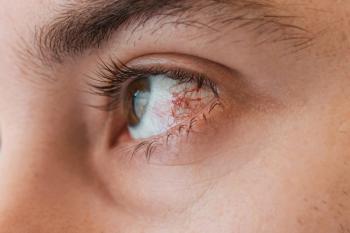
Agent is an excellent choice for allergic conjunctivitis patients, with or without concomitant dry eye
The multi-modal anti-allergy agent epinastine HCl 0.05% is an excellent option for the management of seasonal allergic conunctivitis and a particulary good choice in patients who have dry eye disease as a comorbidity, according to Laurie D. Barber, MD.
Key Points
"Epinastine is a potent antihistamine and offers mast cell stabilizing and anti-inflammatory activities so that it provides rapid relief of existing symptoms and continued control. In addition, the formulation is very soothing on instillation, which helps to establish compliance, and there is in vitro evidence that epinastine causes less inhibition of the muscarinic-3 receptor than other products for treating ocular allergy so that epinastine should be less likely to interfere with tear secretion," said Dr. Barber, professor of ophthalmology, Jones Eye Institute, College of Medicine, University of Arkansas for Medical Sciences, Little Rock.
Making the right choice
The patient reports having been told she had dry eyes, for which she had been using preservative-free artificial tears on a routine basis. Her current complaints included increased burning, itching, redness, and lid swelling. Her examination confirmed ocular surface staining, but also demonstrated conjunctival chemosis along with lid erythema and edema indicative of allergic conjunctivitis.
"Since the patient was using non-preserved artificial tears," Dr. Barber said, "it was possible to rule out a preservative-induced reaction. Further questioning reveals she has experienced a similar course beginning in March of previous years."
After instilling a drop of epinastine into each eye, the patient experienced rapid relief of her burning and itching symptoms.
"Although there are many effective topical multimodal anti-allergy products for managing seasonal allergic conjunctivitis, epinastine has a particular niche for the patient with co-existing dry eye. Furthermore, because it is formulated at a pH of approximately 7, it is soothing and doesn't sting on instillation," Dr. Barber said.
"The tolerability and rapid efficacy experienced by patients who receive an initial drop while sitting in the chair in the exam room are strong motivating factors for them to fill their prescription and use their medication after they leave the office," she said.
Multiple benefits
Although epinastine is indicated for the prevention of itching associated with allergic conjunctivitis, clinical experience shows it also has benefits for relieving the associated swelling and redness. This activity has an important positive impact on quality of life for ocular allergy patients.
"Ocular allergy does not just cause bothersome itching and burning, but it can affect daily life functioning of patients who feel uncomfortable about appearing in public or going to work because of their appearance," Dr. Barber said.
As ocular allergy and dry eye disease are two of the leading diagnoses that bring patients to the eye-care practitioner's office, concomitant presence of these two conditions is relatively common. However, the possibility of dry eye may be overlooked in a patient who presents with the hallmark signs and symptoms of allergic conjunctivitis during allergy season, and patients known to have dry eye may also not receive proper diagnosis and treatment for their allergies if their complaints of bothersome symptoms are assumed to be dry eye-related. Maintaining an index of suspicion for concomitant disease and careful history and examination are essential to establish an accurate diagnosis and provide effective management.
"Ocular symptoms of allergic conjunctivitis generally are limited to itching and burning," she said, "whereas the range of symptoms associated with dry eye is greater and can also include blurry vision, pain, foreign body sensation, and a gritty sandy feeling.
"Seasonal worsening is helpful in suggesting the diagnosis of ocular allergy, as are the findings of swollen, red lids and conjunctival chemosis. Ocular surface staining with vital dyes is needed to determine if there is concomitant dry eye disease."
FYI
Laurie D. Barber, MD
E-mail:
Dr. Barber has been on the Inspire speaker bureau prior to 2008, and she has been a principal investigator in monitored, multicenter clinical research studies for dry eye disease and blepharitis.
Newsletter
Want more insights like this? Subscribe to Optometry Times and get clinical pearls and practice tips delivered straight to your inbox.



















































.png)


